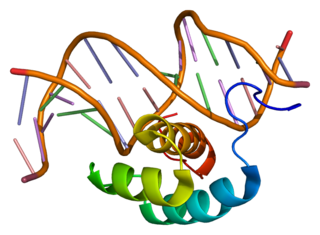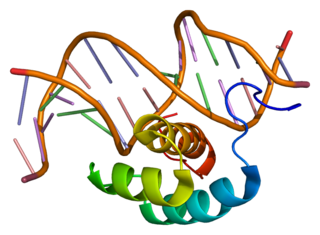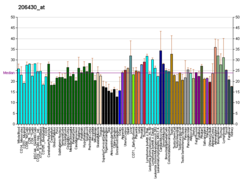
HNF1 homeobox A, also known as HNF1A, is a human gene on chromosome 12. It is ubiquitously expressed in many tissues and cell types. The protein encoded by this gene is a transcription factor that is highly expressed in the liver and is involved in the regulation of the expression of several liver-specific genes. Mutations in the HNF1A gene have been known to cause diabetes. The HNF1A gene also contains one of 27 SNPs associated with increased risk of coronary artery disease.

Homeobox protein CDX-2 is a protein that in humans is encoded by the CDX2 gene. The CDX2 protein is a homeobox transcription factor expressed in the nuclei of intestinal epithelial cells, playing an essential role in the development and function of the digestive system. CDX2 part of the ParaHox gene cluster, a group of three highly conserved developmental genes present in most vertebrate species. Together with CDX1 and CDX4, CDX2 is one of three caudal-related genes in the human genome.

PDX1, also known as insulin promoter factor 1, is a transcription factor in the ParaHox gene cluster. In vertebrates, Pdx1 is necessary for pancreatic development, including β-cell maturation, and duodenal differentiation. In humans this protein is encoded by the PDX1 gene, which was formerly known as IPF1. The gene was originally identified in the clawed frog Xenopus laevis and is present widely across the evolutionary diversity of bilaterian animals, although it has been lost in evolution in arthropods and nematodes. Despite the gene name being Pdx1, there is no Pdx2 gene in most animals; single-copy Pdx1 orthologs have been identified in all mammals. Coelacanth and cartilaginous fish are, so far, the only vertebrates shown to have two Pdx genes, Pdx1 and Pdx2.

Homeobox protein Hox-A9 is a protein that in humans is encoded by the HOXA9 gene.

Homeobox protein Hox-B7 is a protein that in humans is encoded by the HOXB7 gene.

SRY -box 2, also known as SOX2, is a transcription factor that is essential for maintaining self-renewal, or pluripotency, of undifferentiated embryonic stem cells. Sox2 has a critical role in maintenance of embryonic and neural stem cells.

Homeobox protein Hox-A10 is a protein that in humans is encoded by the HOXA10 gene.

Homeobox protein Hox-B6 is a protein that in humans is encoded by the HOXB6 gene.

Homeobox protein Hox-A5 is a protein that in humans is encoded by the HOXA5 gene.

Homeobox protein Hox-A7 is a protein that in humans is encoded by the HOXA7 gene.

Homeobox protein Hox-B9 is a protein that in humans is encoded by the HOXB9 gene.

Homeobox protein Hox-B3 is a protein that in humans is encoded by the HOXB3 gene.

Homeobox A4, also known as HOXA4, is a protein which in humans is encoded by the HOXA4 gene.

Homeobox protein Hox-C6 is a protein that in humans is encoded by the HOXC6 gene. Hox-C6 expression is highest in the fallopian tube and ovary. HoxC6 has been highly expressed in many types of cancers including prostate, breast, and esophageal squamous cell cancer.

Protein atonal homolog 1 is a protein that in humans is encoded by the ATOH1 gene.

LIM homeobox transcription factor 1, alpha, also known as LMX1A, is a protein which in humans is encoded by the LMX1A gene.

Homeobox protein Hox-A2 is a protein that in humans is encoded by the HOXA2 gene.

Homeobox protein Nkx-6.1 is a protein that in humans is encoded by the NKX6-1 gene.

Homeobox protein CDX-4 is a protein that in humans is encoded by the CDX4 gene. This gene is a member of the caudal-related homeobox transcription factor family that also includes CDX1 and CDX2.



















